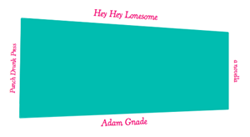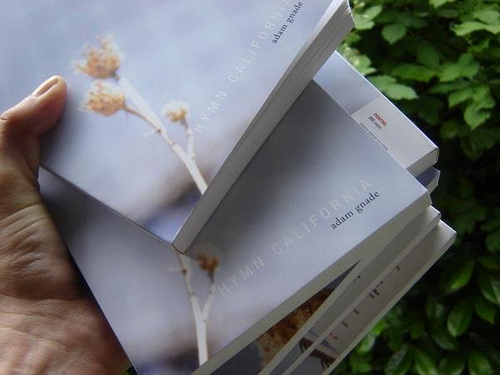 Adam Gnade: Hey Hey Lonesome and The Heat and the Hot Earth (Punch Drunk Press, August and December 2011)
Adam Gnade: Hey Hey Lonesome and The Heat and the Hot Earth (Punch Drunk Press, August and December 2011)
When writers or readers think of literary formats, the lowly novella is often overlooked or forgotten. Usually between 20,000 and 40,000 words, the novella occupies an awkward space between short story and novel, but it offers opportunities for characterization and conciseness that longer or shorter forms don’t. Adam Gnade writes both novellas and novels, and his shorter works stand apart as fascinating experiments in an unusual media form.
Hey Hey Lonesome and The Heat and the Hot Earth were published in 2011 and share a lot in terms of structure and characterization. Both follow a group of teens (and one older character) in Southern California as they navigate relationships and try to find their place in an amorphous social order. Lonesome follows the paths of several characters as they move toward a house party; they move between astonishingly crude and aloof dialogue and highly emotional introspection. Its characters, for the most part, balance outer cool and inner turmoil. Hot Earth is more dynamic and simpler in structure; punctuated by a longing letter and a sneering Tumblr post from two characters, it reflects the callousness and romanticism of the modern teen.
The two novellas are connected through recurring characters and themes, and Gnade notes that he ultimately wants to link these stories with his longer novel, Hymn California, and another novella. Gnade says, “The whole universe of my characters is mapped out in a little three-inch-thick notebook. It’s like a geometric cube of paper. I’m just following that map until it’s done.” The connectedness of the stories gives the novellas a feeling not unlike those big ensemble teen comedies of the ’80s and ’90s; characters move in and out of each other’s orbits, brushing against each other as they go.
For Gnade, his interest in novella was born of necessity and convenience, as well as attachment. He began writing novellas almost by accident: “A couple years ago I was set to do a giant two-month overseas tour, and my publisher at the time had promised that my novel Hymn California was going to be ready to take with me. It got close to the wire and they didn’t have the book ready, so I pulled together some writing and printed up my first novella, Seasons Loving Nothing, on the copy machine at the house I was living in in Portland.” He went on to write three novellas in 2011, including Hey Hey Lonesome and The Heat and the Hot Earth, though he insists that was “a fluke.”
The idea of the novella is close to his heart, however. “I’ve always traveled a lot, and I like things I can carry with me,” he says. “The pocket-size book format is great. I have a lot of smaller books I’ve carried with me around the world and read obsessively wherever I was — stuff that really saves your life, that you know cover to cover, and coming back to it each time is like coming in from the cold.” More than a convenience of form, the novella holds a special significance for Gnade.
Gnade’s novellas are published by Punch Drunk Press, a small press based in San Diego, California. He sees independent publishing as the smartest move for any writer more interested in creativity than profit, and he laments the idea that some writers, by depending on big media to publish them, go unpublished altogether. Independent and smaller publishers are, for Gnade, the answer to a struggling writer’s prayers: “Independent publishing has the potential to keep literature alive if writers actually go for it and opt out of the mainstream press trap. The problem is that a lot of people are too proud, and as a result, beautiful, life-changing works of fiction are wasting away, never to be read.” Getting your work published is more important than what form it eventually takes or how big the print run is, in other words.
His latest venture, a longer novel called Youth is a Wolf Dark and Golden, may not seem to be on the same wavelength as a few novellas, but the ethos behind the work certainly is. “I want to show people how it is to live in the time that I’ve lived,” he says of the novel, “In a way, realist fiction writers can be just as important to historical record as historians.” Both novellas – Hey Hey Lonesome and The Heat and the Hot Earth – are chock full of characters just like us. They aren’t famous or even all that objectively interesting; they talk incessantly about themselves, to others and in print, and they feel nervous about the present and future. Through their stories, Gnade asserts that these kinds of stories — our stories — are worth telling.


